mobile View, to the German Version tap the flag


- Republic of Bashkortostan (Bashkiria)
- own name: Respublika Bashkortostan
- federal component of the Russian Federation (Russia)
• Flag
• Historical Flags
• Meaning/Origin of the Flag
• Coat of Arms
• Map
• Numbers and Facts
• History
• Origin of the Country's Name
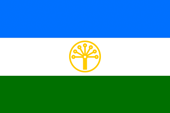
National flag,
ratio = 2:3,
Source, by: Wikipedia (EN)




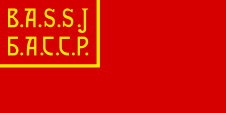
1919–1924,
Flag of the autonomous soviet republic,
ratio = 1:2,
Source, by: World Statesmen



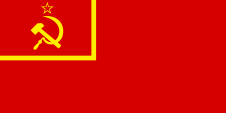
1924–1937,
Flag of the autonomous soviet republic,
ratio = 1:2,
Source, by: World Statesmen



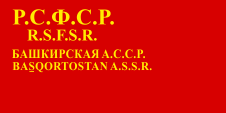
1937–1938,
Flag of the autonomous soviet republic,
ratio = 1:2,
Source, by: World Statesmen



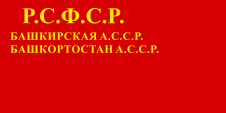
1938–1954,
Flag of the autonomous soviet republic,
ratio = 1:2,
Source, by: World Statesmen



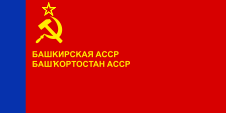
1954–1978,
Flag of the autonomous soviet republic,
ratio = 1:2,
Source, by: World Statesmen



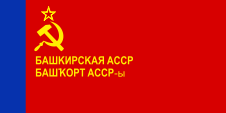
1978–1992,
Flag of the autonomous soviet republic,
ratio = 1:2,
Source, by: World Statesmen



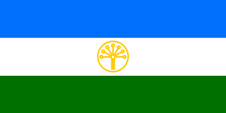
1992–2003,
National flag,
ratio = 1:2,
Source, by: Wikipedia (EN)



look also:
flag history of the soviet republics of the USSR

The flag was adopted on 25th of February in 1992, in the format-ratio of 1:2, on 12th of February in 2003 the format was changed to 2:3. The old format-ratio of 1:2 goes back to the flags of the Soviet Union. The Bolshevist flags were almost designed in 1:2 format, as a visible break with the monarchist and bourgeois format-ratio of 2:3. The flag shows three horizontal stripes in blue, white and green and a golden Kurai Flower in the middle of the white stripe. Blue stands for the integrity and virtue of the Bashkirs and is the colour of the Turkic peoples. White stands for peacefulness, openness and a willingness to compromise. Green stands for freedom and eternal life and is the color of Islam. The Kurai Flower (Salsola Kali) is a symbol of friendship, and its seven petals represent the seven tribes as the foundation for the unity and stability of the Bashkirs. The flags, which were used in the Soviet era corresponded all to the same pattern as it was intended for the Soviet Autonomous Republics: Between 1923 and 1937 frequently only a single-coloured red bunting with a golden inscription, showing the name of the country. Sometimes only as a shortcut, sometimes the full name, sometimes only in Russian or even multilingual. From about 1937 hammer, sickle and star were sometimes added. From about the mid-50s multicolored flags were introduced for the republics of the Soviet Union, whose knitting patterns had to be taken over by the subordinated autonomous Soviet republics.
Source: Die Welt der Flaggen,
Flaggen und Wappen der Welt,
Flaggen Wappen Hymnen,
Flaggen und Wappen

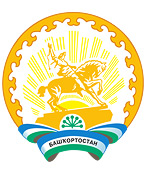
Coat of arms of the Republic of Baschkortostan,
Source:
Russiatrek

Geographical position within Russia:
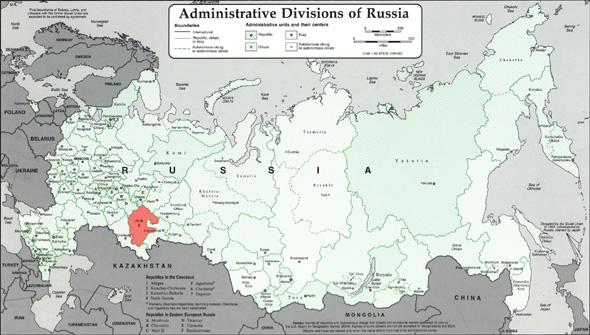
Source: Freeware, russiamap.org,
modyfied by: Volker Preuß
vergrößern/enlarge – hier klicken/click here
Map of the country:
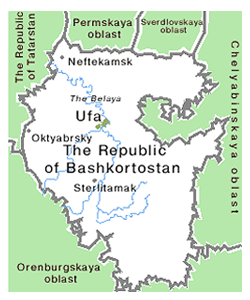
Source:
Russiatrek

Area: 55.192 square miles
Inhabitants: 4.072.292 (2010), thereof 36% Russians, 24% Tatars, 30% Bashkirs
Density of Population: 74 inh./sq.mi.
Capital: Ufa, 1.062.319 inh. (2010)
official Language: Russian
Currency: look Russia
Time Zone: GTM + 5 h
Source:
Infos zur polit. Bildung, Heft 236, 1992, Wikipedia (D)

Paleolith · first settlement
9th century · first mention of the Bashkirs
10th century · start of islamization
13th century · to Empire of the Golden Horde
14th century · Islam becomes the dominant religion
15th century to 1552 · under the rule of the Khanates of Kasan and Sibir
1552 · conquest by Russia
1865 · establish of the Gouvernement of Ufa
1919 · establish of the Soviet dictatorship, foundation of the Bashkirian Autonomous Soviet Republic
1990 · state sovereignty declaration
31st of December in 1991 · the Soviet Union dissolves, the constitution of the Russian Socialist Federative Soviet Republic (RSFSR, Russia), a former substate of the Soviet Union, remains in force for the time being
1992 · rename to Republic of Bashkortostan
25th of December in 1993 · a new constitution for Russia (Russian Federation) comes into force, and the relationships with the members of the federation is re-regulated in this way
Source: Atlas zur Geschichte,
World Statesmen,
Russiatrek,
Die Völker der Erde

The name "Bashkortostan" or "Bashkiria" refers to the people living here, the Bashkir, describing themselves as Baschkurt.
Source:
Die Völker der Erde


![]()




























